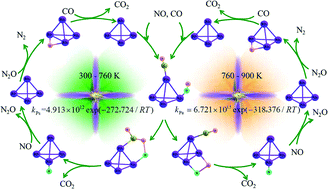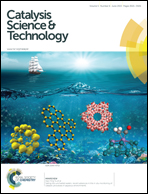Catalytic reduction of NO by CO on Rh4+ clusters: a density functional theory study†
Abstract
An extensive study was conducted to explore the catalytic reduction of NO by CO on Rh4+ clusters at the ground and first excited states at the B3LYP/6-311+G(2d), SDD level. The main reaction pathway includes the following elementary steps: (1) the coadsorption of NO and CO; (2) the recombination of NO and CO molecules to form CO2 molecules and N atoms, or the decomposition of NO to N and O atoms; (3) the reaction of the N atom with the second adsorbed NO to form N2O; (4) the decomposition of N2O to N2 molecules and O atoms; and (5) the recombination of O atoms and CO to form CO2. At low temperatures (300–760 K), the turnover frequency (TOF)-determining transition state (TDTS) is the simultaneous C–O bond formation and N–O bond cleavage, with a rate constant (s−1) of kPs = 4.913 × 1012 exp(−272 724/RT). The formation of CO2 should originate in half from the reaction between the adsorbed CO and NO. The presence of CO in some degree decreases the catalytic reduction temperature of NO on the Rh4+ clusters. At high temperatures (760–900 K), the TDTS is applied to the N–O bond cleavage, with a rate constant (s−1) of kPa = 6.721 × 1015 exp(−318 376/RT). The formation of CO2 should stem solely from the surface reaction between the adsorbed CO and the O atom, the latter originating from NO decomposition. The bridge NbRh4+ is thermodynamically preferred. Once the bridge NbRh4+ is formed, N2O- and NCO-contained species are predicted to exist, which is in good agreement with the experimental results.


 Please wait while we load your content...
Please wait while we load your content...